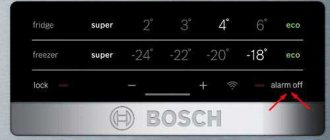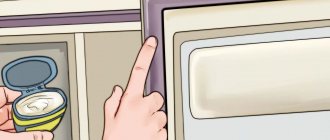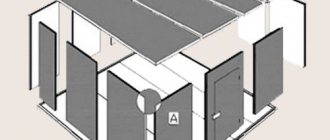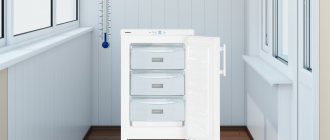There are different options for freezing systems. According to some of them, a freezer surrounded by ice is a normal phenomenon. The condensate cools and settles on surfaces. But if ice forms in the freezer compartment of the refrigerator when using the know frost system, then this indicates a violation. The use of the latter involves removing condensate from the freezing compartment.
How does ice form and how to remove it?
How does No Frost work?
This is a fully automated system that eliminates human participation in its operation. Defrosting of the refrigerator occurs according to a calculated algorithm using special mechanisms. The system independently performs defrosting in forced mode. This is done in a hidden way.
At the same time, the freezing compartment is ventilated. Thanks to the presence of a built-in drip device, condensate is constantly removed from the refrigerator, as a result of which it does not leak. Violation of the output mode may cause frost to form on the surfaces of the freezer.
The idea of creating “NoFrost” involves eliminating situations in which ice forms. For this purpose, a special moisture removal technology is used. A heat exchanger is built into the cavities of the side walls. Increased air movement occurs thanks to the built-in fan heater.
During operation, condensate is retained by the heat exchanger, which has a reduced temperature. Due to this, the chamber walls remain dry and clean. The frost that forms on the evaporator is removed in defrost mode. This happens thanks to specialized heating elements.
Using the know frost system in a refrigerator requires taking into account some features of how food should be stored on the part of the owner. Due to the specific nature of the work, in which there is constant movement of air, rapid airing of the stored material will occur. Accordingly, before putting food in the refrigerator, you need to protect it from external influences (i.e., put it in a container or wrap it in film).
Due to the specific nature of the work, in which there is constant movement of air, rapid airing of the stored material will occur. Accordingly, before putting food in the refrigerator, you need to protect it from external influences
Why does ice form?
One of the likely causes of ice may be a power outage. The mains voltage has gone out, so the refrigerator does not freeze. As a result of downtime, a puddle may appear; the fact that it appears is not always clearly visible and may go unnoticed. After operation is restored, it freezes and ice forms.
Setting the maximum freezing mode can lead to untidy consequences. When you open the door, frost forms, which begins to melt and drip down, resulting in the formation of ice.
To avoid this, it is recommended to keep the freezing temperature at medium. This will not only prevent the occurrence of frost, but will also save some energy. According to the recommendations of most manufacturers. This mode of operation is the most optimal.
When you open the door, frost forms, which begins to melt and drip down, resulting in the formation of ice.
Naturally, opening and closing the door is not the only circumstance leading to the occurrence of icing. The reasons for this phenomenon may include the following:
- Broken door seal. Wear of the rubber seal may result in the door not fitting tightly to the refrigerator body.
- Another reason why ice forms in a refrigerator with the NoFrost system may be clogging of the channels leading water from the heat exchanger with foreign inclusions. Also, one of the pipes could simply have jumped out, as a result of which moisture does not enter it and the movement of water to the container for collecting moisture does not occur.
The container itself is usually located in the same compartment with the motor. Water evaporates from it naturally. The occurrence of icing may be due to the fact that the resulting water does not get to the required place, but is poured into the freezer. There it freezes safely.
- Malfunction of the heating element of the heat exchanger, that is, its combustion. In this case, no one except a service specialist can help.
Important! If the appearance of ice is observed regularly, and the refrigerator is still under warranty, then you should not look for reasons. Moreover, carry out independent repairs. Contact the seller to fix the problem or replace the technical device.
If the appearance of ice is observed regularly, and the refrigerator is still under warranty, then simply return it to the seller - the new refrigerator must work properly
Reasons for ice freezing in a refrigerator with a No Frost system
If an impressive “snow cap” grows in a refrigerator that supports No Frost technology, then the human factor may be to blame. In other words, housewives most often themselves shorten the life of their unit. The main reasons for the formation of ice in a No Frost refrigerator are:
- Selected “Super Freeze” mode. Many No Frost refrigerators support “Super Freeze” technology, which automatically turns on a day after connecting the device to the network. This mode of operation helps maintain the freshness of a large volume of products. If the “Super Freeze” mode is turned on in the refrigerator, then it is not surprising that ice forms in the main compartment and freezer compartment. In order for the ice to disappear, you simply need to turn off the “Super Freeze” mode.
- Incorrect installation of the refrigerator. Manufacturers of household appliances recommend leaving at least 5 cm of free space between the refrigerator and the back wall. Otherwise, there will be improper air exchange in the refrigerator. In other words, heat will not be removed from the back wall of the refrigerator. Consequently, the refrigerator will freeze poorly and dissipate heat poorly. This can lead to the appearance of ice.
- Incorrect cooling mode selected. As mentioned above, many housewives mistakenly set the maximum freezing mode. As a result, ice forms at the bottom of the refrigerator. This is especially true when the temperature in the room in which the refrigerator is installed is too high. Thus, heat exchange between the condenser and the environment becomes increasingly difficult. And when the “Super Freeze” mode is selected, the capacitor is forced to work at full capacity.
- If all the settings of the refrigerator are selected correctly, its installation is also carried out according to all the rules, but ice still forms, this indicates a breakdown of the household appliance.
- Ice in a No Frost refrigerator can form not only as a result of a faulty defrosting system. Sometimes technicians can identify other breakdowns of household appliances. The most common of them are:
- The drainage hole used to drain water is clogged. The drainage channel plays an important role in the operation of the freezer compartment. The drainage hole periodically becomes clogged with dust and dirt, sometimes with food crumbs. As a result, water does not circulate properly through the drainage and accumulates at the bottom of the freezer, then it freezes. In order to eliminate this malfunction, it is necessary to remove the blockage as soon as possible. This can be done using a syringe with warm water. If this does not help, you need to completely defrost the refrigerator. If this measure does not bring results, it is necessary to remove the blockage using improvised means (cables or ropes).
- The temperature sensor has failed. This device regulates the operation of the cooling system. Therefore, if the sensor is broken, it needs to be completely replaced. Long-term operation of the refrigerator with a faulty temperature sensor leads to premature shutdown of the compressor. As a result, the freezer freezes and ice forms.
- The door to the main compartment of the refrigerator is not sealed properly. If the refrigerator door does not close tightly, warm air enters the main chamber. As a result, condensation forms and then ice. In this case, you need to quickly replace the door seal with a new one. This will help restore the tightness of the refrigerator compartment and freezer compartment and return the temperature inside the refrigerator to its previous level. Also, if necessary, you should check the secure fit of the main door to the refrigerator chamber and replace the hinges.
- Refrigerant leak. This malfunction usually occurs as a result of a leak in the cooling circuit. Consequently, it is impossible to achieve the set temperature in the refrigerator chamber; the motor is forced to work on a constant basis. As a result, the main working mechanism of the refrigerator practically does not turn off, overheats and also fails.
How to defrost correctly?
Owners of modern refrigerators with a no-frost system note that the defrosting procedure on some models has to be done quite often. To ensure that this procedure does not lead to breakdown of the technical device, it should be carried out correctly:
- The first thing to start with is disconnecting the refrigeration unit from the power source. That is, remove the plug from the socket.
Before defrosting, you will have to turn off the refrigerator, even by unplugging the cord from the outlet.
- The resulting ice may make you want to remove it mechanically: cut it off with a knife or scrape it off with any other hard object. Under no circumstances should this be done.
The wall thickness of the heat exchanger is small. It will not be difficult to cause damage to it by mechanical force. As a result, the problem will develop into a completely different direction. You will have to contact the service department for repairs, which will not be cheap.
- The defrosting process can be accelerated by using a container of warm water. The use of boiling water is excluded. If the water temperature is close to 100 degrees, its impact on the surfaces of the refrigerator can lead to damage. It is recommended to install the container on a woven material or on a board. To quickly dry it, you can use a hairdryer, but first you need to make sure that the heating function is not turned on.
Some refrigerator users are afraid that defrosting them may cause damage. In this situation, you can entrust the procedure to the technical device itself. After the defrosting process is completed, the person will only need to remove excess moisture.
After completing the defrosting process, remove excess moisture by wiping all parts and containers with a soft cloth
Next, you need to wait a while (about half an hour) before returning the products to their places. This is necessary for the refrigerator to return to standard operation. This is most relevant in the warm season.
After completing the defrosting process, remove excess moisture by wiping all parts and containers with a soft cloth
Remember! Refrigerators with “NoFrost” require defrosting only when there are any malfunctions. The main advantage that was pursued when developing the operating process of the system is the absence of the need for defrosting, due to the removal of moisture by the technical device itself.
Additional Operating Notes
- The cooling mode must be selected correctly. A high ambient temperature does not mean that it is necessary to set the freezer to the maximum possible power.
- Placing containers with hot food in the refrigerator may cause the temperature sensor to malfunction. If it is also open, the actively evaporating moisture will lead to the formation of ice. Often, this becomes the simplest cause of ice formation.
Let hot food cool before putting it in the refrigerator
- Do not overload the refrigerator with food. This may cause the compressor to overload. Extreme operating mode will lead to its failure.
Loading the refrigerator too tightly can cause the compressor to overload.
Contact the master
A very common situation when calling a technician is the installation of expensive spare parts instead of disassembling and removing a clogged tube. Therefore, it is better to seek help from an official repair service center for a specific brand. The only difficulty with such repairs is the need to transport the device, since authorized services rarely work at home, and if they come, it is only to take the freezer to the workshop (of course, delivery in both directions is paid by the client). In many modern devices, manufacturers have taken care to prevent the problem of ice freezing by installing additional heating during production to drain melt water.











